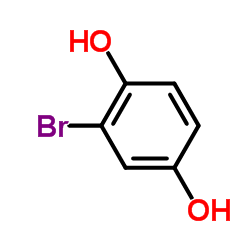Differential uptake of isomeric 2-bromohydroquinone-glutathione conjugates into kidney slices.
S S Lau, M G McMenamin, T J Monks
Index: Biochem. Biophys. Res. Commun. 152(1) , 223-30, (1988)
Full Text: HTML
Abstract
2-Bromo-(diglutathion-Syl)hydroquinone (2-Br-[diGSyl]HQ) is a more potent nephrotoxicant than any of three mono-substituted isomers. The reason for this differential toxicity is unknown. We now report that the rate of uptake of 2-Br-(diGSyl)HQ, 2-Br-3-(GSyl)HQ, 2-Br-5-(GSyl)-HQ and 2-Br-6(GSyl)HQ by kidney slices was 2.4, 1.2, 1.0 and 0.3 nmoles/mg/10 min, respectively. AT-125 (0.5 mM) inhibited gamma-glutamyl transpeptidase (GGT) in intact and homogenized kidney slices by 47% and 92%, respectively and decreased the accumulation of the isomeric [35S]-conjugates by 49%, 21%, 25% and 30%, respectively. The data suggest that the accumulation of 2-Br-(GSyl)HQ conjugates into isolated kidney slices may in part be mediated by GGT and that the more extensive renal uptake of the di-substituted conjugate may be partially responsible for its enhanced nephrotoxicity. In addition, 2-Br-(diGSyl)HQ gave rise to the most covalently bound material of the different isomers studied suggesting that both physiological and biochemical factors contribute to the potent and selective nephrotoxicity of this compound.
Related Compounds
| Structure | Name/CAS No. | Molecular Formula | Articles |
|---|---|---|---|
 |
2-bromohydroquinone
CAS:583-69-7 |
C6H5BrO2 |
|
Dihydroxylated mercapturic acid metabolites of bromobenzene.
1992-01-01 [Chem. Res. Toxicol. 5(4) , 561-7, (1992)] |
|
Inhibition of respiration in rabbit proximal tubules by brom...
1986-01-01 [Adv. Exp. Med. Biol. 197 , 911-7, (1986)] |
|
Cellular toxicity of bromobenzene and bromobenzene metabolit...
1986-05-01 [J. Pharmacol. Exp. Ther. 237(2) , 456-61, (1986)] |
|
Synthesis and nephrotoxicity of 6-bromo-2,5-dihydroxy-thioph...
1988-07-01 [Mol. Pharmacol. 34(1) , 15-22, (1988)] |
|
2-Bromohydroquinone-induced toxicity to rabbit renal proxima...
1989-06-01 [Toxicol. Appl. Pharmacol. 99(1) , 11-8, (1989)] |